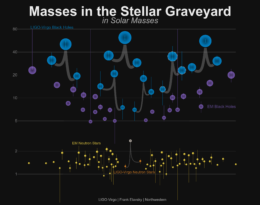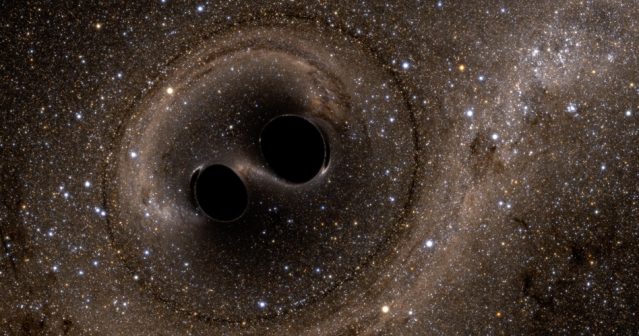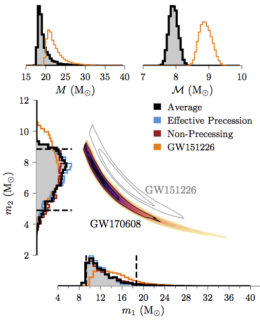Wednesday evening the Laser Interferometer Gravitational-wave Observatory (LIGO) collaboration quietly mentioned that they’d found gravitational waves from yet another black-hole binary back in June. This casual announcement reveals what is so far the lightest pair of black holes we’ve watched merge — opening the door for comparisons to the black holes we’ve detected by electromagnetic means.
A Routine Detection

The chirp signal of GW170608 detected by LIGO Hanford and LIGO Livingston. [LIGO collaboration 2017]
GW170608, a gravitational-wave signal from the merger of two black holes roughly a billion light-years away, was detected in June of this year. This detection occurred after we’d already found gravitational waves from several black-hole binaries with the two LIGO detectors in the U.S., but before the Virgo interferometer came online in Europe and increased the joint ability of the detectors to localize sources.
Overall, GW170608 is fairly unremarkable: it was detected by both LIGO Hanford and LIGO Livingston some 7 ms apart, and the signal looks not unlike those of the previous LIGO detections. But because we’re still in the early days of gravitational-wave astronomy, every discovery is still remarkable in some way! GW170608 stands out as being the lightest pair of black holes we’ve yet to see merge, with component masses before the merger estimated at ~12 and ~7 times the mass of the Sun.Why Size Matters
With the exception of GW151226, the gravitational-wave signal discovered on Boxing Day last year, all of the black holes that have been discovered by LIGO/Virgo have been quite large: the masses of the components have all been estimated at 20 solar masses or more. This has made it difficult to compare these black holes to those detected by electromagnetic means — which are mostly under 10 solar masses in size.

GW170608 is the lowest-mass of the LIGO/Virgo black-hole mergers shown in blue. The primary mass is comparable to the masses of black holes we have measured by electromagnetic means (purple detections). [LIGO-Virgo/Frank Elavsky/Northwestern]
Now, detections like GW170608 and the Boxing Day event (which was also on the low end of the mass scale) are allowing us to start exploring spin distributions of non-accreting black holes to determine if we’re right in our understanding of black-hole spins. We don’t yet have a large enough comparison sample to make a definitive statement, but GW170608 is indicative of a wealth of more discoveries we can hope to find in LIGO’s next observing run, after a series of further design upgrades scheduled to conclude in 2018. The future of gravitational wave astronomy continues to look promising!
Citation
“GW170608: Observation of a 19 Solar-mass Binary Black Hole Coalescence,” B. P. Abbott et al 2017 ApJL 851 L35. doi:10.3847/2041-8213/aa9f0c


1 Comment
Pingback: another gravitational wave detection